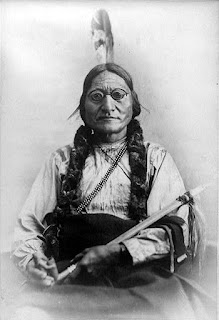 | Digital ID: cph 3a14645. Source: b&w film copy neg. Reproduction Number: LC-USZ62-12276 (b&w film copy neg.) , LC-USZ62-122855 (b&w film copy neg.) Repository: Library of Congress Prints and Photographs Division Washington, D.C. 20540 USA. Retrieve uncompressed archival TIFF version (1,473 kilobytes) Unedited Image (35253 bytes) |
TITLE: [Sitting Bull, half-length portrait, seated, facing front, holding calumet]. CALL NUMBER: LOT 12940. [P&P]. REPRODUCTION NUMBER: LC-USZ62-12276 (b&w film copy neg.) LC-USZ62-122855 (b&w film copy neg.) MEDIUM: 1 photographic print on cabinet card mount. CREATED, PUBLISHED: c1881.
Works published prior to 1978 were copyright protected for a maximum of 75 years. See Circular 1 "COPYRIGHT BASICS" from the U.S. Copyright Office. Works published before 1923 (THIS IMAGE) are now in the public domain.
CREATOR: Goff, O. S. (Orlando Scott), 1843-1917, photographer. NOTES: 1263(?) U.S. Copyright Office. On verso: O.S. Goff, Bismarck, D.
REPOSITORY: Library of Congress Prints and Photographs Division Washington, D.C. 20540 USA. DIGITAL ID: (b&w film copy neg.) cph 3a14645 hdl.loc.gov/cph.3a14645. (b&w film copy neg.) cph 3c22855 hdl.loc.gov/cph.3c22855. VIDEO FRAME ID: LCPP003A-14645 (from b&w film copy neg.) CONTROL #: 99402403
Sitting Bull From Wikipedia, the free encyclopedia
Sitting Bull (Sioux: Tatanka Iyotake or Tatanka Iyotanka or Ta-Tanka I-Yotank, first named Slon-he, (Slow), (c. 1831 – December 15, 1890) was a Hunkpapa Lakota medicine man and holy man. He is notable in American and Native American history in large part for his major victory at the Battle of the Little Bighorn against Custer’s 7th Cavalry, where his premonition of defeating them became reality. Even today, his name is synonymous with Native American culture, and he is considered to be one of the most famous Native Americans in history.
The Battle of Killdeer Mountain struck a significant blow against Native American resistance, and many chiefs gave up the fight and went to reservations. Sitting Bull refused to surrender and rose to be a tribal leader, leading his warriors in a siege against the newly-constructed Fort Rice in present-day North Dakota. This action won him respect among the tribe, and he became head chief of the Lakota nation in c. 1868. During this period, white settlers, miners, farmers, missionaries, railroad workers, and military personnel began to expand the United States, and Native Americans were increasingly being forced from their tribal lands.
Sitting Bull, who was a medicine man, began to work toward uniting his people against this invasion. Like many tribal leaders, Sitting Bull first attempted to make peace and trade with the whites. However, many of the men the Lakota encountered would trick them into accepting poor deals for their lands and produce, which created resentment amongst the tribes. After the discovery of gold in 1876 in the Black Hills, his people were driven from their reservation in the area, a place that the Sioux considered holy. Sitting Bull took up arms against the whites and refused to be transported to the Indian territory.
This article is licensed under the GNU Free Documentation License. It uses material from the Wikipedia article, Sitting Bull
Technorati tags: Public Domain Clip Art and clip art or public domain and Native American Heritage Month or Sitting Bull or Bloodrocuted and Native American Heritage Hollow Horn Bear and Nanofabrication method paves way for new optical devices












No comments:
Post a Comment